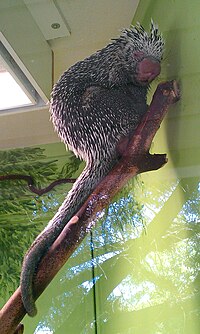| Prehensile-tailed porcupines Temporal range: Early Pleistocene to Recent [1] | |
|---|---|
 | |
| Coendou prehensilis | |
| Scientific classification | |
| Domain: | Eukaryota |
| Kingdom: | Animalia |
| Phylum: | Chordata |
| Class: | Mammalia |
| Order: | Rodentia |
| Family: | Erethizontidae |
| Subfamily: | Erethizontinae |
| Genus: | Coendou Lacépède, 1799 |
| Type species | |
| Hystrix prehensilis | |
| Species | |
See text | |
The prehensile-tailed porcupines or coendous (genus Coendou) are found in Central and South America. [2] Two other formerly recognized Neotropical tree porcupine genera, Echinoprocta [3] and Sphiggurus, [4] have been subsumed into Coendou, since Sphiggurus was shown by genetic studies to be polyphyletic, while Echinoprocta nested within Coendou. [5]